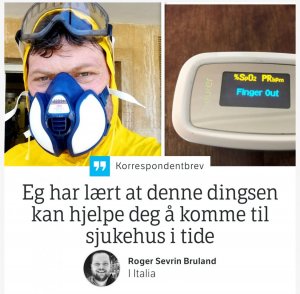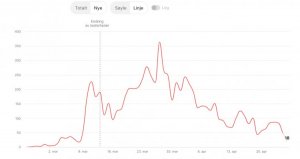Starting on 13 March 2020, all people working in non-essential functions in the public sector were ordered to stay home for two weeks.[7] In the private sector, employers are urged by the authorities to allow their employees to stay home in the same period and work from there if possible, although this should not affect functions that are essential to the society (such as pharmacy workers and people working with sale of food and maintenance of critical infrastructure).[86] On that same date, all secondary education (like gymnasiums), universities, libraries, indoor cultural institutions and similar places were closed, initially for two weeks. Starting on 16 March, all primary schools, daycare and similar places were also closed for two weeks.[7] Virtual (online) schooling was used to some degree.[87] The municipalities are establishing limited daycare for children where the parents could not stay home and take care of them. Because of the vulnerability of elderly to COVID-19, it was strongly recommended that grandparents should not take care of their grandchildren.[88]
Starting on 18 March at 10:00 AM, a number of further restrictions were activated: it became illegal to assemble more than ten people in public, all shopping centres and stores with close contact such as hairdressers and nightclubs must be closed, restaurants can only serve take-away, and other businesses must ensure that there is enough space between customers.[89] Unlike previous restrictions on the number of people allowed to assemble, the new restrictions are not merely a recommendation, and breaking the new restrictions is associated with fines of DKK1500.[89] On 23 March, it was announced that the above lockdown measures would be extended for a further 2 weeks, and be in place until 13 April.[90]
In late March, authorities acknowledged that the strategy of mitigation had partially worked, but had been less successful than the mass testing in China and South Korea.[91] Efforts were increased for immediate testing (at Novo Nordisk),[92] mass testing[93] and local rapid testing for individuals.[94]
International travel, quarantine after return and foreign visitors[edit]
The Danish Foreign Ministry has changed its travel guidelines several times during the coronavirus outbreak. During the peak of the outbreak in the Chinese mainland, Iran, the regions of Aosta Valley, Emilia-Romagna, Lombardy, Marche, Piedmont and Veneto in Italy, Ischgl in Tyrol of Austria, and San Marino, all travel to these places was advised against, and during the peak in the rest of Italy, the rest of Tyrol in Austria, Madrid, Basque Country and La Rioja in Spain, parts of Germany, parts of France, parts of Switzerland, and Daegu City and North Gyeongsang Province (also known as Gyeongbuk) in South Korea, all non-essential travel to these places was advised against. On 13 March, all non-essential travel to the rest of the world was advised against because of the spread of the outbreak, restrictions introduced on foreign visitors (for example, restrictions of flights or forced quarantine), their healthcare system's ability to handle a major outbreak or other reasons indirectly related to the coronavirus pandemic.[95][96][97][98][99][excessive citations] On 13 March, the authorities recommended that all Danes that were abroad (excluding Danes that live abroad) return to Denmark as soon as possible.[96][100] From 14 March to 13 April, all Danish borders were closed, with exceptions made solely for the transport of goods, people with an important reason for visiting, foreigners leaving Denmark, and Danes and people with a residence permit returning to Denmark.[101][102]
On 3 March, the Danish government required all healthcare workers (in addition to nursing home workers) who had travelled to a high-risk region to self-quarantine themselves for 14 days after returning to Denmark; this was done to reduce the risk of vulnerable people getting infected.[103] As of 9 March, the list of high-risk regions included mainland China, part of South Korea, Iran, Italy and the Austrian state of Tyrol.[104] Other people who had visited these high-risk areas were advised against visiting hospitals or nursing homes for 14 days after returning to Denmark (and people who suspected that they had been infected were urged to call their personal doctor or the doctor-on-call (Danish: Lægevagten) for further instructions[105]), and it was recommended—but not required—that they also stay home from work for 14 days.[106] This recommendation was supported by the employers' organisations in the country, such as the Confederation of Danish Industry and the Danish Chamber of Commerce.[107][108] Kommunernes Landsforening, which represents the municipalities in Denmark, made similar recommendations for all children that had visited a high-risk region; it recommended that they stay home from school, kindergarten, daycare and similar places for 14 days after returning to Denmark.[109] Foreigners that arrive in Denmark from a high-risk region were urged—but not required—by the authorities to follow the same guidelines as Danes, and localities for quarantining were made available for people that did not already have a suitable locality.[110]
Starting on 9 March, passengers on flights that originated in a high-risk region were not given access to Danish airport buildings, but instead were picked up directly from the plane and transported by special buses that could drive them to their home or other locality of quarantine.[110][111] From 11 March onwards, all flights from high-risk regions were cancelled.[112]









